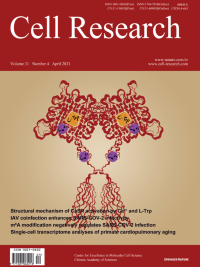
Advanced Search
Submit Manuscript
Advanced Search
Submit Manuscript
Volume 31, No 4, Apr 2021
ISSN: 1001-0602
EISSN: 1748-7838 2018
impact factor 17.848*
(Clarivate Analytics, 2019)
Volume 31 Issue 4, April 2021: 482-484 |
Cryo-EM structures of the full-length human KCC2 and KCC3 cation-chloride cotransporters
Ximin Chi1,2 , Xiaorong Li1,2,3 , Yun Chen1,2 , Yuanyuan Zhang1,2 , Qiang Su1,2 , Qiang Zhou1,2,*
1Westlake Laboratory of Life Sciences and Biomedicine, Key Laboratory of Structural Biology of Zhejiang Province, School of Life Sciences, Westlake University, Hangzhou, Zhejiang 310024, ChinaDear Editor,
The electroneutral K+-Cl− cotransporters (KCCs) play fundamental roles in trans-epithelial transport, cell volume regulation, and neuronal excitability.1 The neuronal-specific KCC2 (SLC12A5) and glial-expressed KCC3 (SLC12A6) are essential for normal development and function of the nervous system. Mutations in KCC2 have been linked with human idiopathic generalized epilepsy2 and schizophrenia.3 KCC3-dependent Cl− transport across the choroid plexus epithelia is involved in the production of cerebrospinal fluid.4 Here, we present single particle cryo-electron microscopy (cryo-EM) structures of the full-length human KCC2 and KCC3 at overall resolution of 3.2 and 3.3 Å, respectively (Fig. 1a, b; Supplementary information, Figs. S1, S2 and Table S1). The structures of KCC2 and KCC3 are very similar to each other. For simplicity, we mainly focused on KCC3 for structural analysis. KCC3 exists as a dimer in domain-swapping conformation (Fig. 1a). A marked difference is observed in the C-terminal domain (CTD) compared with Danio rerio Na+-K+ Cl− cotransporter 1 (DrNKCC1), which rotates ~70° clockwise as seen from cytosolic side when transmembrane (TM) domains aligned together (Supplementary information, Fig. S3a). The TM domain and CTD are connected through a pair of scissor helices (Fig. 1b), which separate the two TM domains from different protomers resulting in a unique “Central Cleft” between TM domains at the cytosolic side (Fig. 1b). The extracellular domain (ECD) of the two protomers are placed in distance (Fig. 1b). Both TM domains, scissor helices and CTD are involved in dimerization of the transporter. The TM domain of KCC3 is captured in an inward-facing conformation, sharing the LeuT-fold as the members of the amino acids, polyamines and organocations (APC) superfamily (Fig. 1b), with TMs 3–5 and 8–10 forming the scaffold domain and TMs 1, 2, 6 and 7 constituting the bundle domain (Fig. 1c). Three ion-like densities are found in the unwound region of TM1 and TM6 in KCC3 (Supplementary information, Fig. S3b, left), to which we assigned two Cl− ions and one K+ ion with the consideration of both coordination environment and structural similarity with KCC1. In the cryo-EM map of KCC2, the densities for K+ and one of Cl− ions are absent. Instead there is a weaker density similar to that is observed in KCC1 purified in NaCl condition5 (Supplementary information, Fig. S3b, right). Amino acid substitution of tyrosine (Y407 in KCC2) to phenylalanine (F441 in KCC3) causes subtle change in the ion binding site, which might provide a possible explanation for the ion coordination differences between KCC2 and KCC3 (Supplementary information, Fig. S3c).
https://doi.org/10.1038/s41422-020-00437-x